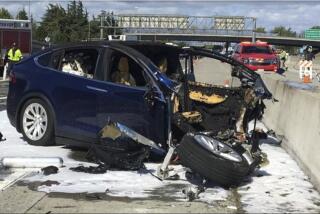THE CUTTING EDGE : In the Information Age, Everyone’s a Revolutionary
- Share via
The dictionary says that technology is “the application of science, especially to industrial or commercial objectives.” But it’s hard, just using that one word, to capture some of the technology-inspired changes that have occurred merely in the past decade or so.
The best Intel microprocessor--these are the brains of most desktop computers--performed 2.6 million instructions per second in 1983. Last year, the comparable chip performed 112 million instructions per second.
At that rate of increase, Montgomery Ward will soon be selling what we now think of as supercomputers right next to the refrigerators, for the same price as today’s average personal computer. One difference might be that instead of using one of these devices to write your aunt in Minneapolis, you’ll use it to visit with her.
Texas Instruments, meanwhile, has developed what it hopes will be a lower-costhigh-definition television system based on 2.3 million infinitesimal aluminum mirrors attached on a kind of hinge to a computer the size of a large postage stamp. Responding to a digital TV signal, the mirrors move back and forth to reflect pulses of colored light and produce crystalline images.
This is a miracle of miniaturization, of course, but the real miracle is the microprocessor, which is already having an impact on a par with those earlier shapers of modern life, television and automobiles.
To try to keep abreast of the changes that flow from the computer revolution, the Los Angeles Times Business section will offer expanded coverage of technology and its effects on business and the people who use it. In this section, we offer something of a snapshot of the Information Revolution--a progress report on a process well underway.
Starting Wednesday--and on every Wednesday after that--we’ll explore these issues in one or more pages of technology coverage appearing in Business under the banner of The Cutting Edge.
One reason is that the changes wrought by technology are often manifest in business before they become a familiar part of everyday life. Another is that, so far, the biggest impact has been felt by and through companies and workers.
During the 1980s, when business spent hundreds of billions of dollars on computers, there was little measurable gain in productivity, the implication being that the money had basically been thrown out the window.
But new discoveries always need time to take hold. It took years for the Royal Navy to embrace citrus fruit, even though it was known to cure scurvy, but eventually British sailors became limeys. The advent of electric engines didn’t immediately transform manufacturing--until the people who created factories in those days thought to redesign their plants to exploit the power of the new machines. Once they did, productivity soared. The current “jobless recovery” isn’t really jobless, of course, but the relatively slow growth of employment reflects, in part, the ability of business to do more and more work without adding staff. This is possible in large part because people have finally figured out how to use their computers. Another factor is that they have also learned to trust them, so instead of adding computing to the paper pushing, firms are changing the way they do business altogether to take full advantage of the computing power now widely available.
Theoretically, this will be good for everybody. After all, rising productivity is a key to prosperity in any society. But as with most change, there will be winners, and there will be losers.
It’s been said that all revolutions eat their children, and this one will no doubt do more than a little snacking. Some job categories will disappear, even as others emerge. A variety of skills will follow the blacksmith into the sunset. And workers without a good education--or an awful lot of native drive--could find themselves in trouble.
Yet the opportunities this revolution presents--for community, for entrepreneurship, for personal freedom--seem vast in comparison with the pitfalls. In most places where they have been introduced, computers have proved themselves instruments of democracy, with consequences few could have foreseen beforehand.
And besides all that, we really don’t have much choice. The one thing clear by now is that, at this late date, there’s no going back.






